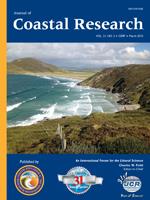Jia, M.; Wang, Z.; Liu, D.; Ren, C.; Tang, X., and Dong, Z., 2015. Monitoring loss and recovery of salt marsh in the Liao River Delta, China.
Coastal salt marsh plays an important role in the aquatic food web and the export of nutrients to coastal waters. The salt marshes in the Liao River Delta of China, dominated by Suaeda heteroptera, experienced a dramatic loss in the 1990s and then recovered in the 2000s. This study investigates these changes of salt marsh using a time series of Landsat Thematic Mapper (TM) images acquired in 1988, 1995, 2000, 2004, 2007, and 2009. The classification tree method was used on these TM images to extract S. heteroptera, and an interactive self-organizing data analysis algorithm was used to determine other land cover types. The conversions between salt marsh and other land cover types were described with conversion matrices. The classification results show that, during 1998–2004, salt marsh decreased dramatically at an average rate of 662.68 ha/y. However, during the period 2004–2009, salt marsh recovered gradually at a rate of 115.51 ha/y. The conversion matrix indicates that, from 1988 to 2004, a large area of former salt marsh was directly replaced by man-made landscape types, such as reed field (5111 ha), aquaculture pond (2655 ha), reservoir (1720 ha), and paddy field (729 ha). In contrast, the result for the period from 2004 to 2009 shows that salt marshes were recovered by the conversion of some areas of former barren beaches and river back to salt marsh. Driving forces analysis suggests that salt marsh dynamics were mainly caused by human activities, with the secondary drivers being climatic warming and dry conditions.





